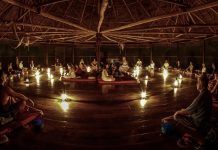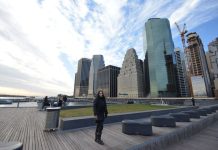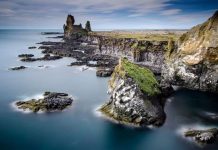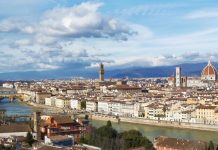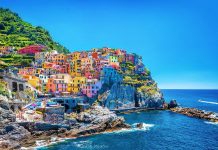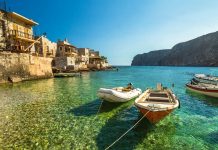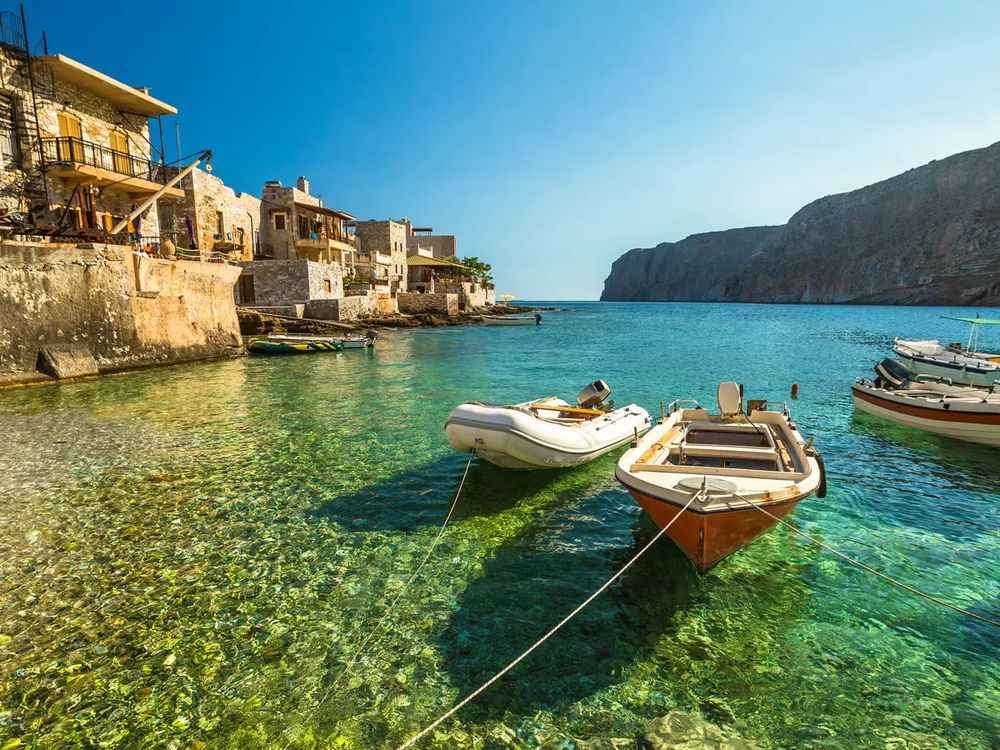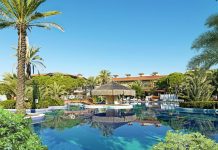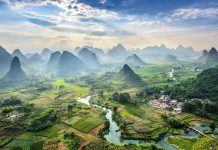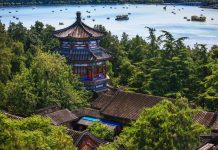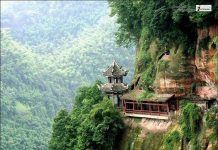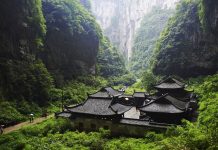Achillion: Achillion is the palace that princess Sissy (Elizabeth) of Austria built, at Gastouri village, and it is the emblem of a whole era. It was built in the late 19th century, when Sissy sought for a calm place away from her country, after the death of her son. She had already visited Corfu (Kerkyra), in 1861, invited at Mon Repos by the English commissioner, Herny Stoks, and had started, since then, studying the history of the island and the Greek mythology.
The palace, of Pompeian manner, was devoted to Achilles, the hero that, according to Sissy, represented the Greek soul and the beauty of the local people.
It is an imposing building, with pillars, balconies, gables, statues and frescoes, with impressive gardens orned with masterpieces either ordered or brought from the Borghese villa in Rome, on the slope of a green hill, with stunning view over the Halikiopoulos lagoon, Kanoni, Pontikonissi and mount Pantokratoras. Until her assassination in 1898 in Vienna, by an Italian anarchist, Sissy has spent several summers here, learning Greek and reading Goethe, Shakespeare and Homer.
Here, you can admire the impressive fresco on the ceiling, at the entrance of palace, by the Italian painter Galoppi, which, symbolically, depicts the Four Seasons and the Horae (Hours). In the background, you will see a majestic marble staircase with statues of Zeus and Hera at the bottom. The staircase leads to the first floor, which, for the time being, cannot be visited.
At the main hall, you will also see, the fireplace by black Italian marble with the small statues of Athena and Hebe, the dorated clock, the portrait of Elisabeth and the “chapel” with the icon of Panaghia (Virgin Mary), where Sissy used to pray.
Still at the ground floor, there is a room devoted to the next owner of Achillion, the emperor (Keizer) of Germany, Wilhelm II, who bought it in 1908 and has been spending his holidays here until 1914.
At the yard, going up the small staircase, you will see the marble statues of Apollo, Hermes, Artemis and Aphrodite and you will be leaded to the Muses Peristyle (at the back of the palace, outdoors of the first floor). Here, at the small arch that is created by colourful ionic pillars, you will be able to admire, through the glass window, the famous and huge oil painting “Achillles’ Triumph” or “Triumphant Achilles” by the Austrian Frantz Mats, considered to be the most artistically important artpiece of Achillion.
Going down the stairs from the Muses Peristyle, you will see two of the most famous statues of the palace: Sissy’s favourite statue and emblem of Achillion, the lyrical marble “Dying Achillles” by Ernst Gustav Herter and the bronze “Victorious Achilles” by Goetz, installed by Wilhelm II.
In summer, the place is full of visitors. (tel.: 00302661056210-11, 56245).
Annunciata/Annunziata: Annunziata (translated in Greek as Evaggelistria) is the famous Catholic church of Lontsiada, devoted to the Annunciation and to Aghia Loukia (Santa Lucia, in latin). It was built in the 14th century, but, today, the bell tower and a part of the sanctuary have only been saved.
Annunziata is a monument of Paneuropean importance, since it is here that the Latin Nobles, who were killed at the naval battle of Nafpaktos (1571), were buried. Nafpaktos naval battle was the largest naval battle ever seen to that day and was the end of the marine threat of the Turks.
After the devastation of the church, during the Nazi bombardments on 14/9/1943, the bones were transferred to the Catholic Cemetery of Corfu (Kerkyra), at the Cappuccini region.
Archaeological Museum of Corfu (Kerkyra): The Archaeological museum is located in Corfu (Kerkyra) town, on the coastal road to Garitsa (1, Vraila Armeni St.) and houses the findings that come almost exclusively by Corfu (Kerkyra) Island from the Archaic, Classic, Hellenistic and Roman period. In the early 20th century, the, then small, archaeological collection of Corfu (Kerkyra) has been housed at the high school, but, later on, it has been transferred to a building, built in order to house the new museum. However, because of the enrichment of the exhibits, it had to be built another new hall. Until its development, the exhibits were housed at Aghios Georgios and Michael palace (1962-1965). The current museum has opened in September 1967 and its initial purpose was to house the archaeological findings from the Temple of Artemis Gorgo. In 1994, it was expanded with the addition of two more exhibit halls that display the more recent findings at the ancient citadel (acropolis) of Corfu (Kerkyra).
In the museum halls, educational programs and periodical painting exhibitions are held (tel.: 00302661030680, 43452).
For the Archaeological Museum of Corfu (Kerkyra), the Old fortress, the temple of Antivouniotissa and the Museum of Asian art, you can buy one single entrance ticket.
Banknotes museum: The museum was established in 1981 by the Ionian Bank and it is housed at the former historic Ionian Bank building, designed by the Corfiot architect, Ioannis Chronis in about 1840. The Banknotes Museum is unique in Greece and one of the few and most interesting around the world. Ionian Bank chose Corfu (Kerkyra) to house its museum, as it was here, in this building, that its development has started, more than a century before. In 2000 Ionian Bank merged with Alpha Bank and subsequently the Banknote Museum was renovated and reopened in 2005.
The museum showcases an almost complete collection of the Greek currency from 1822 to present, with the replacement of the drachma by the euro in 2002, about 2000 items. The large and rare collection of the bank includes, banknotes issued from 1839 till 1920, the first banknote of Greece “Foinikes”, printing plates of Greek banknotes, the rare 1860 “colonata”, rare documents, seals, photographs, coins, stamps etc categorized in the first floor.
In winter, the museum opens only for groups of visitors (schools, universities, tourist groups etc) (tel.: 00302661080342).
Byzantine collection of Corfu (Kerkyra)-Paleo Frourio (Old fortress): Byzantine collection of Corfu (Kerkyra) is housed at the 1550 gateway of the old fortress (Paleo Frourio), which extends back in twin buildings, which in Venetian times were used as guardhouses. (The guardhouse on the left (as you come in) is used by the Archaeological Resources Fund for the sale of models, reproductions and other items). All the exhibits (approximately 40), that constitute the current collection, are part of the old Byzantine collection from the Museum of Asian Art. The collection includes the mosaics from the basilica of Paleopolis, fragments of frescoes from the church of Aghios Nikolaos in Kato Korakiana village, which were removed from the wall and restored in 1970 and the sculptures from the old collection from Paleopolis and other Byzantine sites on the island (tel.: 00302661048310, 48120).
For the Archaeological Museum of Corfu (Kerkyra), the Old fortress, the temple of Antivouniotissa and the Museum of Asian art, you can buy one single entrance ticket.
Byzantine Museum (Antivouniotissa): The byzantine museum of Antivouniotissa was created in 1979, after the donation οf the church of Panaghia Antivouniotissa (Virgin Mary) to the Greek state. The church is one of the oldest churches in Corfu (Kerkyra) town (probably built in the 15th century) and one of the most important monuments of post-Byzantine period. It was named after the hill Antivouni or Ovreovouni (the current Kampielo), on which the church is built. After the necessary restoration of the building, the exhibition was opened to the public in the 1980’s, featuring rare Byzantine art.
The collections exhibited include significant icons and relics from the Byzantine and Post-Byzantine periods. Some of them are: the icon of Aghios Kyrilos (Saint Cyril) of Alexandria (1654), the icons of Aghios Sterghios, Aghios Bacchus and Aghia Justina (referred to the victory of European forces at the naval battle of Nafpaktos, in 1571) and the icon of Theotokos Hodegetria (Virgin Mary holding baby Jesus, end of 15th century A.D.).
(tel.: 00302661038313).
For the Archaeological Museum of Corfu (Kerkyra), the Old fortress, the temple of Antivouniotissa and the Museum of Asian art, you can buy one single entrance ticket.
Corfu (Kerkyra) Shell Museum/Sea Museum: The Shell museum in Corfu (Kerkyra) was created by the diver and collector Napoleon Sagias, in 1989. At the beginning, the museum was situated at Benitses, but its enormous collection had been augmented with new exhibits brought back by the owner from Australia. As a result, the Museum has moved into new premises on the main road at Gouvia, near the cross-roads. The museum is unique in Greece and it is one of Europe’s best museums dedicated to shells and other treasures of the deep.
The museum includes more than 10.000 fantastic and beautiful species, like: sea-shells, sponges, corals, embalmed fish, fossils lobsters, crab, smakes, sharks and jaws, starfish, sea urchins etc. from the Pacific and Indian Oceans and from the Mediterranean Sea. The collection is scientifically labelled and you will be also offered a guided tour with full explanations and descriptions. Unusual shells for collectors and exotic souvenirs are on sale, too.
The museum has received a merit from the Research Institute I.R.E.D.A. of Italy.
(tel.: 00302661072227, 42900, 99340).
Historic Folklore Museum of Middle Corfu: The historic folklore museum was created in August 1982 and is located in Sinarades village, 14km far from Corfu (Kerkyra) town. In the museum the inside of a house is restorated, in the way the everyday life and tradition of the residents of the villages of Corfu (Kerkyra) were in the 19th century.
It includes furniture, handicraft, kitchen utensils, tools, musical instruments, traditional costumes and clothes etc. (tel.: 0032661054962).
Kapodistrias Museum: The museum and the centre of Kapodistrian Studies was established in 1981 and donated by Maria Desylla-Kapodistria, Mayor of Corfu (Kerkyra) (1956-1959) and the first woman ever to be elected Mayor in Greece.
It is housed in the summer home of Ioannis Kapodistrias, the Foreign Affairs Minister of Russia and the first governor of Greece, located in Koukouritsa, in his birthplace at Evropouli village, it commemorates his life and accomplishments and has been named in his honour.
The exhibits of the museum include furniture and heirlooms of the time and personal items of Kapodistrias (tel.: 00302661039528).
Municipal Gallery: The Municipal Art Gallery started its operation in 1978, housed at Dalietos building. After several years of inactivity, in August 1995, started the attempt of its reopening in the palace of Aghios Georgios and Aghios Michael (Saint Michael and Saint George).
The biggest part of the collection, here, is donated or consists of works of artists of the 19th and 20th century. Most of these artists are Corfiot (Ch. Pahis, who founded the artist school in Corfu (Kerkyra), P. Prossalendis the younger, G. Samartzis, A. Giallinas, V. Boccaciambis, S. Scarvelis, L. Koyevinas, N. Ventouras). The 19th is the century, when some of the most characteristic Eptanisian artists are coming forward and the turn of the artists to the impressionistic movement will offer a different but decisive tone to the Corfiot artistic production.
Among the most famous exhibits are: “The Assassination of Kapodistrias” by Ch. Pahis, “Markas” and “Flock” by A. Giallinas, “The Sphinx” by Sp. Scarvelis, “Warrior of ’21” by Sp. Prossalendis, “Arab Musician” by P. Prossalendis. During the end of the 19th century, Today, there are a lot of activities at the Municipal Gallery, as, besides the main exhibitions, many exhibitions, presentations, lectures, artistic lessons, concerts, educational programs for children etc are held (tel.: 00302661039553, 44606).
Museum of Asian/Far Eastern Art- Saint Michael & Saint George Palace: The museum contains wonderful collections from countries of Asia/ Far East and it is unique in Greece and also, one of the best in Europe. It is located in Spianada square, inside the palace of Aghios Georgios and Aghios Michael (Saint Michael & Saint George Palace), which is the most important monument of the English rule, in the island. This building was the headquarters of the British Army Staff, the headquarters of the Ionian Senate, as well as the summer residence of the former Royal Family of Greece.
It was converted into a museum in 1927, when the collector of Asian artworks, Grigorios Manos, ambassador in Paris and Vienna and diplomat, decided in 1919 to donate its interesting and numerous collection of 9.500 items to the Greek State.
Its collections include Japanese items, like weapons and masks, Chinese items from the Mingh, Soungh, Cheu, Chan, Wei, Ching dynasties, furniture, portraits, medals, paintings and heirlooms and objects from India, Tibet, Pakistan, Cambodia, Korea, Thailand and Nepal. Some of the most interesting exhibits of the museum are the masks of the Japanese theatre “ΝΟ” from Ento era (1615-1868), the weapons and brass objects of the Samurai’s, the famous Arita or Imari porcelains etc. (tel.: 00302661030443-20193).
For the Archaeological Museum of Corfu (Kerkyra), the Old fortress, the temple of Antivouniotissa and the Museum of Asian art, you can buy one single entrance ticket.
Museum of Ceramic Folklore Art/Ceramics museum: The museum is located at the English Barracks, in the new fortress (Neo frourio) of Corfu (Kerkyra) town. It includes various ceramic objects of everyday use, as well as folklore items from Corfu (Kerkyra) (tel.: 00302661027370).
Olive oil museum: The museum is housed in a perfectly preserved olive mill of the early 20th century, at Kynopiastes village. It includes a large collection of tools and means for the elaboration of olives for the production of olive oil, as well as tools of the local farmers. The olive tree is the typical flora of the Corfiot land and its cultivation is one of the main agricultural activity of the Corfiots.
Paleopolis Museum (Mon Repos): “Mon Repos” is 3km far from Corfu (Kerkyra) town and its green land is extended for 258sq. m. . It is situated at the biggest part of the hill of Analipsis, where the ancient town of Corfu (Kerkyra), Paleopolis, was located. It is considered to be the best location in the island. The grandiose building in the centre of the garden is the palace that, in 1824, the English commissioner Frederic Adam has built, as his summer resort. Later on, it became the rural house for every commissioner during the English rule, even later the rural house for the king George I, who gave it the name “Mon Repos”, and, finally, after the abolition of monarchy and long trial adventures, came to the hands of the municipality of Corfu (Kerkyra) and today operates as a museum, part of the Archaeological Museum.
Mon Repos houses archaeological findings from the excavations in Paleopolis area (the current Kanoni), covering the period from Archaic to Roman years. The luxurious palace has three floors and it is one of the earliest neoclassic buildings in Greece, inspired by the English manner.
Its exhibition includes objects of the 19th century, related to the use of the palace (documents, furniture, portraits etc.) and the whole property (painting collections with plants etc), archaeological findings from the ancient Paleopolis, as well as photo exhibition from the excavation procedure (tel.: 00302661041369).
Reading Society of Corfu (Kerkyra)/Corfu (Kerkyra) Literary Society: The Reading Society of Corfu (Kerkyra) is situated in the opposite side of St.Michael and St.George Palace, at Mouragia and it is the oldest intellectual institution of Greece. It was founded as a “Literary Club”, by foreign graduates of universities that were sent away from Italy as “carbonari”, during the period of English Protection (1814-1864), in order to come in contact with political, scientific and intellectual activities of Western Europe.
The first president was the important philosopher, politician, diplomat and professor of the Ionian Academy, Petros Brailas-Armenis (his property was bought by Princess Sissy, to build the Achillion). The role of the Reading Society proved to be decisive for the history of the island and the Ionian Islands (Eptanisa). The claiming of the members of the Company for the establishment of the free press, as well as the imposition of the Greek language as an official language in the Ionian islands contributed considerably to the attribution of Eptanisa, by the English, in Greece, in 1864.
Its priceless library has 10.000 volumes of Eptanesian bibliography, newspapers, booklets, old maps, engravings and photos. The Reading Society is a member of the European Federation of Associations and Institutions “Europa Nostra” and was rewarded in 1978 from the Athens Academy for its rich and profound action.
Today, the Society organizes many activities, like picture galleries, lectures, seminars, scientific congresses and musical happenings (tel.: 00302661044165).
Serbian Museum “The Serbians in Corfu (Kerkyra) 1916-1918”: The “Serbian Hearth” or the “Serbian House” is situated near Spaniada square and it is the building where the Consulate of Federal Republic of Serbia and the Museum of “the Serbs in Corfu (Kerkyra) 1916-1918” are accommodated. In the Museum there are various objects from the Serbs of the World War I, like maps, photographs, documents, flags, uniforms, arms and equipment etc.
During the World War I, the Austro-Hungarian, German and Bulgarian army prevailed the Serbian army in the Serbian front. As a result, the Serbs (about 152.000 Serbian soldiers) left their country and found shelter in Corfu (Kerkyra), the “Island of Salvation”, as they called it.
The monument of Stone Cross (1922) and the Mausoleum-Ossuary (1936) were set up, commemorating the Serbian soldiers (tel.: 00302661033960).
Solomos Museum and the Corfiot Studies Society: Solomos museum, the centre of Solomos studies and the Corfiot studies society are housed in the house that lived the most of his life and until his death, the national poet of Greece, Dionysios Solomos.
Here, you will see the poet’s desk, a small autograph, old photos, maps and portraits of famous Corfiots and manuscripts and other personal items of the poet in the Greek and Italian language (tel.: 00302661030674).
Dionysios Solomos was born in Zante (Zakynthos), in 1798, completed his studies in Italy, where he was influenced by the Italian literature, returned to Zante, but after problems with his brother, he decided to come to Corfu (Kerkyra), where he lived until his death (1828-1857). His talent was recognized right after his return from Italy, although his reputation in Greece and in Europe was due to the publication of his poem “Hymn to the liberty” (1823), one of his first Greek poems, inspired by the Greek Revolution of 1821. Solomos was a significant personality of his time, affecting not only the Greek revolution, but also the Italian revolution (Manzini, Emilio & Attilio Bandiera).

